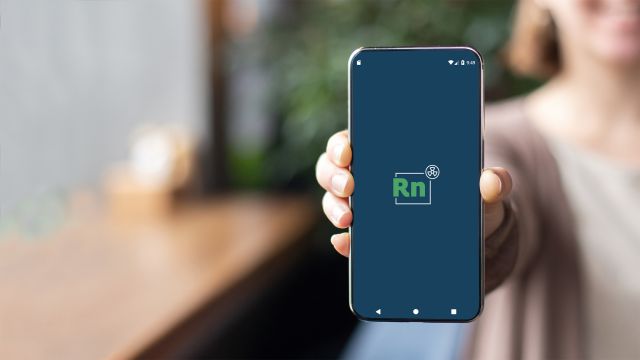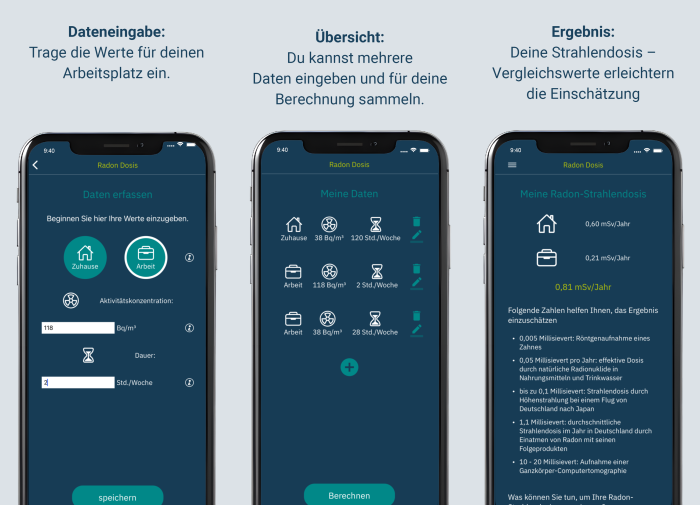
Radiation protection: New GRS app helps to categorise radiation exposure from radon
Radon is a natural radioactive noble gas. It is produced by the natural decay of the chemical elements uranium or thorium. Both elements are widespread in the earth's crust and can be found practically everywhere. The concentration of radon in soil, air and drinking water varies locally and regionally and depends on the amount of natural uranium or thorium in the soil. The concentration of radon indoors is highly dependent on the construction method, condition and utilisation.
In buildings, radon can accumulate primarily in the basement and on the ground floor. However, radon also occurs in certain building materials. Inhaling large quantities of radon and its radioactive decay products over a longer period of time can increase the risk of lung cancer. Radon is the second most common cause of lung cancer in Germany after smoking.
How much radon is there where I live?
The Federal Office for Radiation Protection produces maps for the whole of Germany that show measured results and forecasts of regional radon releases. The values are shown in becquerels (Bq). This unit of measurement indicates how active a radioactive material is, i.e. how many nuclear transformations/decays take place per second. As radon is a radioactive noble gas, the activity is considered for the room volume in cubic metres (m3).
In some areas of Germany, an increased concentration of radon is found in an above-average number of buildings, as uranium is present in the soil in above-average concentrations here. These regions are known as radon-prone areas. In Germany, these include the Black Forest, the Bavarian Forest, and the Fichtelgebirge and the Erzgebirge regions. In the radon-prone areas, stricter requirements apply to protection against radon, e.g. for new buildings or at the workplace. Each Land had to check for the first time by the end of 2020 whether there were any radon-prone areas in the respective Land and designate them accordingly.
New app calculates radiation exposure due to radon
The Radon Dose app calculates the so-called "effective radiation dose" caused by the radioactive noble gas radon. This is a measure of the radiation exposure caused by ionising radiation - often colloquially referred to as "radioactive radiation" - taking into account the varying sensitivity of different types of different organs and body parts.

As a starting point for the calculation, the app uses information on the activity concentration in the unit "becquerel per cubic metre (bq/m3)" and the length of stay, subdivided according to place of work and place of residence. Either measured or estimated values can be used for this information. As the concentration of radon in a specific building is influenced by many external and internal factors, a reliable statement on the radon concentration is only possible by measurement.
A good overview of the average regional becquerel values can be found in the Radon Handbook published by the Federal Office for Radiation Protection. The result of the app's calculation is given as an annual radiation dose in millisievert (mSv).
The app calculates the radon dose on the basis of scientific assumptions and models. Radon Dose is based on the recommendations of the Radiation Protection Ordinance (StrlSchV), the Commission on Radiological Protection (SSK), and the International Commission on Radiological Protection (ICRP). However, as reality is often much more complex than a calculation model, the result is to be understood as an estimate and not as an exact prediction.
Comparative values for radiation exposure from certain everyday applications of ionising radiation - e.g. the X-ray of a tooth or a computer tomography - help to better classify the results. At the same time, the app gives users tips on what they can do in the event of higher levels.
According to the Federal Office for Radiation Protection, even small measures can reduce the radon level indoors and thus the health risk. These include regular ventilation of contaminated rooms. On-site measurements can be used to check whether the measures taken were successful.
App available from the App Store and Google Play
The Radon Dose app is now available for free download from the App Store and Google Play. Personal data is only stored on the user's own device. The app does not access other user data or forward such data to third parties.